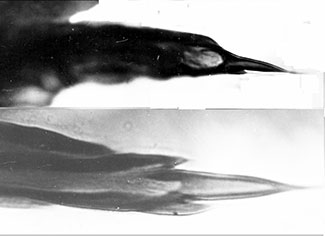C. magnivalva Kieffer, 1917, immaturesLarva: a medium sized plumosus-type larva. Length (females) about 11.3 - 14.5 mm. Anterior ventral tubules slightly longer than the posterior pair. Gular region at least slightly darkened on posterior half, frontoclypeus also darkened to some extent.
Mentum with 4th laterals only slightly reduced (essentially type I), and c2 teeth only partly separated from c1 (type I). Ventromentum with about 28-29 striae. Pecten epipharyngis with about 14-15 teeth.
Antenna with relatively long basal segment, over 4 times as long as wide; AR about 1.88 - 2.13.
Mandible with 3rd inner teeth showing some colour and separate (type IIIB); about 11-16 furrows near the base. Cytology: 4 polytene chromosomes with the pseudothummi arm combination AE, BF, CD, G.
Arm G closely paired with a small nucleolus near the middle of the arm, and three Balbiani rings (BRs), two just distal to the nucleolus and the other near the somewhat heterochromatic centromere. The most distal BR is not always developed.
Nucleolus in arm F at about group 19. No polymorphism known in Australian samples.
Irradiation experiments suggest the MD may be on either arm B or on chromosome CD.
magA1: 1 - 2c, 3 - 2d, 10 - 12, 14 - 13, 4 - 9, 15 - 19
magB1: A puff with some dark bands on distal side, may be developed near the distal end of the arm
magE1: 1 - 3e, 5 - 10b, 4 - 3f, 10c - 13 i.e. as cingulatus, etc.
magF1: 1 - 2a, 10d-a, 2b - 9, 11 - 23 Specimens identified as C. magnivalva in Australia, Fiji and Tahiti, differ from those identified as C. crassiforceps from Japan by a fixed inversion in arm E and more complex changes in arm G. Pupa: Colour yellowish brown, muscle scars slightly darker; shagreen complete on tergites II-VII, anterior quarter on TVIII, none on TIX.
Length about 6.55 (6.3-6.8) mm (female) and 6.33 (5.04-6.7) mm (male); posterior margin of wingcase about 1.44 (1.4-1.5) µm (female), about 1.34 (1.1-1.5) µm (male); female antennal sheath about 450 (340-550) µm. Cephalic tubercles 57.3 (51-71) µm (female), 71.0 (56-83) µm (male) long and usually wider than long in females but longer than wide in males; some slight indication of frontal warts, also a small tubercle about 21.4 (15-28) µm long and 1.0-2.2 times longer than wide, just anterior to the respiratory scar. Respiratory base 109-159 µm long and 46-66 µm wide, respiratory fibres narrowing in middle, HR 2.45 (2.1-2.7).
About 87 (55-105) recurved spines on second segment, occupying just over half of the segment width (subject to mounting distortion). Pedes spurii B difficult to see on available specimens and only determined for segment II; pedes spurii A on segment IV about 116-182 µm long and about 0.22 (0.13-0.27) of segment length. L-setae at III/IV margin at least 50-106 µm long and at IV/V margin at least 71-96 µm long.
Spurs dark yellow brown, with about 1-3 spines plus 1-3 small spines in many cases where there is only 1 large spine. 
Variation of pupal spur of C. magnivalva (Sarina, Qld above; Nadi, Fiji, below)Taeniae on anal fin in up to 3 rows towards the posterior end; about 53-115 taeniae but more in females (mean 96.7) than in males (mean 79.3). [ Return to Index | Go to References | Go to C. magnivalva adult ] |
